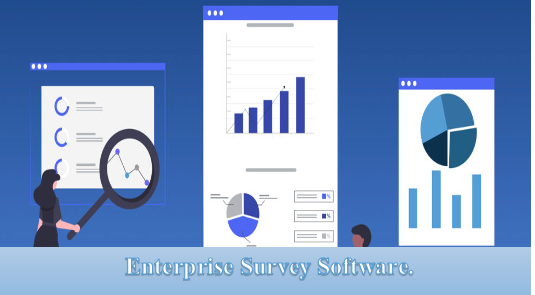Enterprise survey software provides the power of complex survey tools to an organisation through backed data and security control.
This allows the organisation to collect data that comply to its internal and external security standards.Through survey,you will get insights for your business brand,Quality leads and how to manage your marketing.
Does your organization require the best Enterprise survey software? Well, we have the answer for you. We have researched and tested some of the best software regarding survey and now it’s time for you to select your best suit.
Let’s dive in.
1.Questionpro.

Online survey software called QuestionPro Enterprise survey software runs on both the web and mobile devices.
It offers more than 250 templates for customer satisfaction, market research, academic research, and other purposes, assisting users in developing customized, multilingual, and real-time surveys.
By utilizing intuitive dashboards, organizations may see patterns in the workforce and get real-time employee input. Through access to analytical methodologies, it enables teams to get useful insights, produce segmentation data, and track customer behavior.
Its market research modules include Van Westendorp pricing, conjoint analysis, MaxDiff analysis, card sorting, A/B test results, heatmap analysis, and more.
By combining survey results with antiquated CRMs and marketing tools, the FTP sync integration automates procedures.
Features of Questionpro.
1.Surveys: Design countless, fully adjustable online and offline surveys. Include sophisticated question types like the conjoint analysis, max-diff scale, NPS, and discrete choice. Filter responses based on criteria including language, geolocation, device, status, and other elements. Provide kiosk surveys for iOS and Android.
2.Market Research: Discover qualitative and quantitative business insights through market research using research tools.
3.Closed Loop System: Resolve encounters that have been identified as red proactively. Utilize ticketing systems to swiftly resolve problems.
4.Sentiment Analysis: Use text analytics powered by artificial intelligence to categorize comments and reviews as favorable, negative, or neutral. Gather information from many sources, such as surveys, written materials, and social media.
5.NPS: Use NPS scores to classify customers into promoters, detractors, and passives and predict customer attrition.
6.Dashboards: Data sharing, consumer profile access, trend tracking, and data filtering based on specific survey questions are all available. Customize chart types, labels, and widgets.
7.Email Metrics: Track email survey results to gauge the success of a campaign. View the average click, bounce, and open rates.
8.Integrations: Connect to Salesforce, Microsoft Dynamics 365, HubSpot, Sugar CRM, Google Analytics, Zoho, and more through integrations.
2.Alchemer.
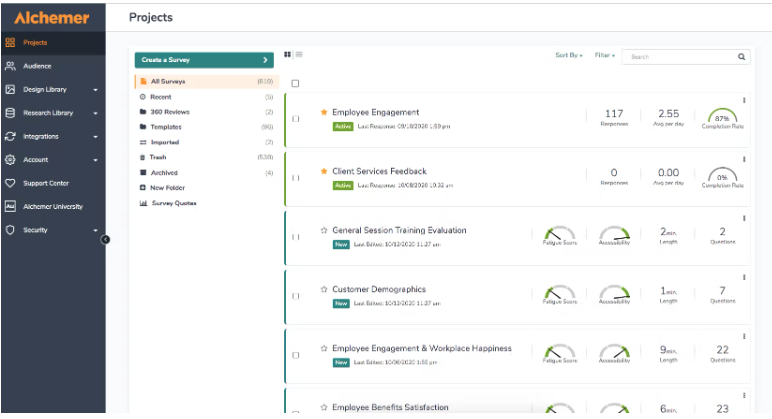
A feedback management tool that aids organizations in gathering and analyzing feedback are called Alchemer Enterprise survey software (formerly known as SurveyGizmo).
It enables teams to design and publish sophisticated surveys to obtain critical information from markets, consumers, and employees.
To collect customer sentiment on a micro level, it provides a Voice of the Customer (VoC) program. Risk evaluation and management of employee experience are further competencies.
Features of Alchemer.
1.Surveys: Customize surveys by employing different question kinds and sophisticated logic, such as question, page, and skip logic. Send them out through website pop-ups, social media, email, and other methods. Provides pre-built NPS surveys.
2.Feedback Management: To establish a single source of truth, feedback management should gather insights at various points along a customer’s journey.
- Communication Management: With standardized, already-designed communication workflows and notifications, you can personalize client interactions from prospecting to post-purchase. In communications and evaluations, include brand-centric information.
- Integrations: For a complete customer perspective, integrate Salesforce with Microsoft Dynamics. Connect with analytical and communication tools like Slack, Tableau, HubSpot, MailChimp, Jira, and others. Make specialized integrations with current business systems.
- Consumer journeys: Track customer interaction at several touchpoints and segment the data.
- Workflows: Direct pertinent people or teams to receive consumer input. Dashboards powered by workflows allow managers and leaders to track the status of product development. Send out automated emails in response to customer behavior.
3.Product Input Management: By gathering and examining customer feedback, goods can be improved and patterns can be found. Transform unstructured insights into useful data.
4.Reporting: Has built-in modules for market research analysis and reporting.
3.Medallia.
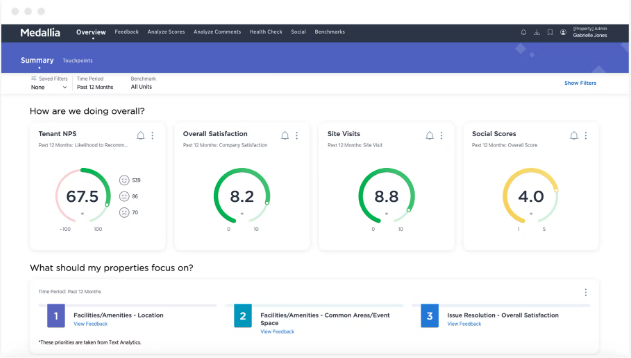
The cloud-based platform Medallia Enterprise survey software offers data-driven analytical modules to manage the customer and employee experience.
It is scalable and secure. By allowing for client engagement via the web, email surveys, messaging, mobile feedback, IVR processes, IoT devices, and other digital channels, it aids teams in capturing signals across all touchpoints.
By analyzing survey insights, measuring talent lifecycles, and deploying role-based dashboards, users can optimize the workforce experience.
Organizations can recognize possibilities on both ends thanks to qualitative insights and real-time notifications that give a complete picture of the employee and consumer profiles.
Marketers can utilize A/B tests and product feedback management to collect feedback on product qualities, test prototypes, target customer segments, visualize user journeys, and test user interfaces.
With Workplace by Facebook, Salesforce, Marketo, and other antiquated connectors, real-time integrations are possible.
Features of Medallia.
1.Omnichannel: Gather customer information through all points of contact using branded surveys, in-app evaluations, online intercepts, messaging platforms, phone and chat recordings, and IVR systems. Utilizing omnichannel feedback, comprehending client journeys, and enhancing engagement.
2.Segmentation: Using segmentation, you can target customers, forecast their behavior, find opportunities, and model the risk of attrition while providing tailored experiences.
3.Analytics and reporting: Use dashboards to get practical information about consumer satisfaction and product visibility. Based on the dynamic organizational structure, continuously sync. Utilizing in-memory analytics, display data points in real-time.
4.Case Management: Using role-based procedures push notifications, and automated escalations, case management may help you efficiently resolve client complaints. To provide personalized interactions, use built-in templates.
5.Management of input: Gather feedback via a variety of channels and apply controls to guarantee accurate outcomes. Gather feedback at key moments and avoid oversampling.
6.Artificial intelligence: Analyze comments, determine at-risk clients, discover common themes, and pinpoint pressing issues. Performance evaluations can be used to examine a program’s health.
7.Reputation Management: Manage your reputation by gathering feedback from more than 25 social media platforms, including TripAdvisor, Twitter, Facebook, and Google. To receive alerts for new reviews and to respond within the system, set triggers. Maintain the company’s online reputation by enhancing search engine rankings and monitoring comments for competitors.
8.Integrations: Using RESTful APIs, you can manage workflows, start campaigns, automate operations, and share data in real-time. Profit from your connections to Slack, Workplace by Facebook, Salesforce, Marketo, and other services.
9.Text Analytics: Take actionable insights from textual feedback with text analytics. Text from surveys, review websites, social media, emails, agent notes, and other sources can all be analyzed.
10.App for smartphones: Get real-time feedback findings, allocate dashboards depending on roles, and respond to emails all from within the app.
4.Qualtrics.
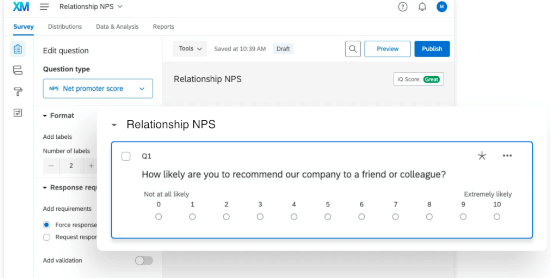
An enterprise’s customer, employee, product, and brand experiences are improved through Qualtrics Enterprise survey software, a web- and mobile-based platform.
Through real-time feedback, useful data, precise targeting, and prescriptive insights, predictive intelligence, and analytics assist teams in gaining a thorough understanding of client demands and experiences.
Monitoring app store reviews can help businesses identify ways to enhance their services and get better ratings.
Access to connectors with CRMs, ticketing systems, chat features, and analytics modules like Adobe Analytics, Google Analytics, FullStory, and Quantum Metric is available to users.
Additionally, it offers market segmentation, brand tracking, ad testing, pricing analysis, and more.
Features of Qualitrics.
1.Automation: Automatically send notifications and suggested actions to the right teams. In CRMs, ticketing systems, and messaging apps, use drag-and-drop connectors to establish a uniform system of operation.
2.Digital Optimization: Customer engagement on digital channels should be streamlined through digital optimization.
3.Dashboards: Use them to make programs, establish digital listening posts, and gather feedback. Deliver feedback surveys via applications, mobile devices, and the web by using drag-and-drop modules.
4.Artificial Intelligence: Utilizing AI modules, you may identify trends and patterns as well as forecast client behavior.
5.Reputation Management: Manage your reputation by extracting information from web sources, automatically requesting favorable reviews, and publicly responding to negative ones. Review brand reputation across all digital platforms, follow location-specific trends and analyze user sentiment.
6.Personalization: Decrease turnover by identifying high-risk customers and foreseeing their behavior. For questions and issues, create tickets to enable prompt follow-ups. Communicate with clients via SMS, chatbots, email, websites, apps, and other channels to provide individualized encounters.
7.Customer feedback (VoC): Consider customers when making important business decisions. Find out in real time what the most important factors are for both new and returning customers’ pleasure. Provide products, features, and extras that are tailored.
8.NPS: Use the Net Promoter® Score to improve the customer experience, find disgruntled consumers, divide them into loyalty groups, compare them to other companies and industry benchmarks, and keep tabs on product advancements.
9.Feedback management: Use ticketing systems, root cause analysis, resolution tracking, and text and statistical analysis to quickly respond to consumer feedback. Using triggers, convert feedback into tickets automatically. Role-based dashboards allow you to keep an eye on tickets, customer happiness, team output, and first-call resolution.
10.Surveys: Through surveys, you may raise brand awareness and customer retention. Choose from pre-built surveys or design your own using the drag-and-drop user interface. Send surveys using all available channels, including email, text, offline and native apps, chatbots, and more.
5.Sogosurvey.
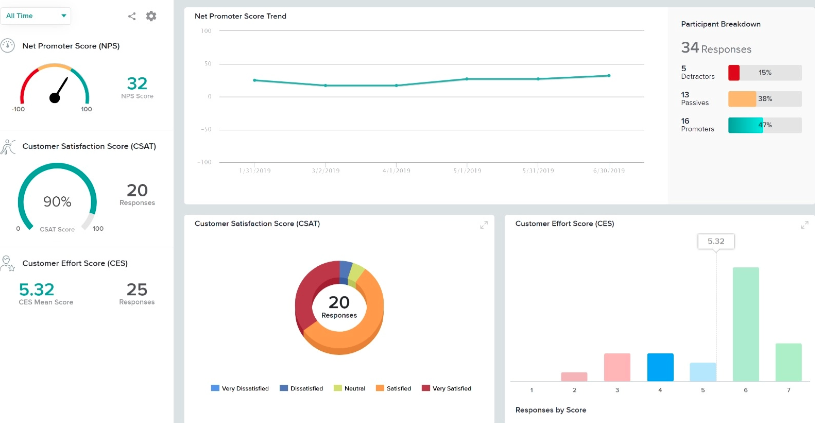
A cloud-based application called SoGoSurvey Enterprise survey software makes it easier to manage user experiences and gather feedback.
Users that have access to omnichannel feedback can analyze customer sentiment and turn it into useful insights. Tools like the poll creator and form builder can be used by businesses to collect important data points.
It offers surveys that are media-rich, bilingual, and customizable. With the SHA-256 cryptographic hash technique and PCI DSS compliance, user security and data protection are guaranteed.
Reporting, data management, and interfaces with Zapier are further services available.
Features of Sogosurvey.
1.Mobile app: Access survey data, disseminate tools for gathering input, share reports, and acquire insights while on the move. Connect with clients, monitor participation, and program automated reminders from anywhere.
2.Create polls: To analyze the general public’s viewpoint and gain insightful information.
3.Form Builder: Create user-friendly, multilingual online forms that make it easier for participants to sign up. Use skip logic to make sure the audience sees the right questions. Provides templates for things like volunteer sign-ups, training evaluations, job applications, and more.
4.Online Assessment: Utilize the self-grading online assessment module to gauge participants’ comprehension and proficiency.
5.Analytics: Use useful information to determine customer priorities and make informed decisions.
6.Omnichannel: Gather input through a variety of channels, including social media, online surveys, emails, forms, and texts.
7.Ticket Management:
- Organize your tickets into categories according to your industry.
- Utilize answer templates and bulk action modules to react swiftly.
- Prioritize chats and mark them as “important” using system and user-generated tags.
- Inquire about the level of support received for resolved tickets. View both the positive and negative scores and benchmarks against them.
- Provides quick access to customer information, action buttons, a timeline, and categories on the ticket.
6.Zoho Crm plus.
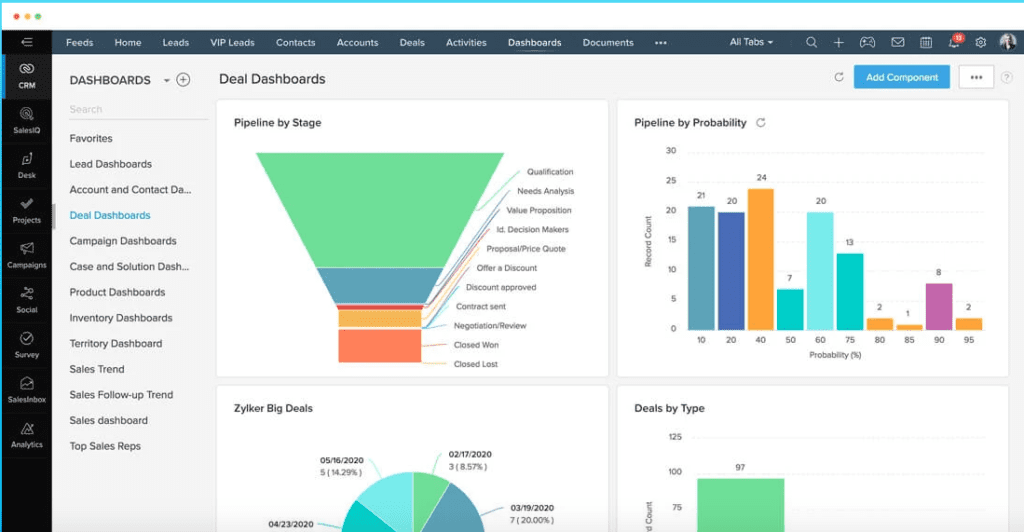
Across all phases of a customer’s life cycle, Zoho CRM Plus helps businesses create and deliver tailored interactions.
It mostly serves teams that interact with customers. Along with its features for sales and marketing automation, Zoho CRM also provides modules for visitor tracking; help desk, project collaboration, social media management, customer surveys, and Zia, an AI-powered live chat assistant.
Sales, marketing, and support staff can act contextually, manage interactions, and stay informed in real-time with access to a comprehensive customer view in a single spot. It also includes the Zoho CRM Enterprise edition.
Features of Zoho Crm Plus.
1.Omnichannel Communication: Utilize several channels to communicate with clients, such as the phone, email, live chat, surveys, and social media.
- Emails: Sending tailored emails and campaigns requires the use of contextual data from lead and customer records. Send messages based on consumer behavior both before and after the sale.
- Social media: Engage with leads there and share campaign content.
- Phone: Calls can be placed, received, transferred, and recorded using a phone.
- Offline: Send email campaigns while traveling, monitor local prospects, scan business cards, and update customer information.
2.Collaboration: Teams from the sales, marketing, and support departments can communicate deliverables, share status updates, and talk about projects in one place.
- Access to a transferable customer database is made available.
- Providing tools like milestone tracking, task lists, calendars, forums, and reporting makes sure that teams stay on schedule.
- Stay informed by receiving reminders for appointments, tasks that need to be completed, and allocated support tickets.
- In documents and presentations, citing team members.
- Emojis, GIFs, and photos can be used to communicate in group chats.
3.Support Management: Using information from all channels, support management may contextually respond to client tickets. Using a knowledge base and pre-written responses improves customer support.
4.Dashboards: To highlight sales objectives and monitor team progress, create personalized dashboards. Establish several KPIs and targets. Get a complete picture of sales activity and segment it by salespeople or teams. Utilize progress bars to visualize performance.
5.Real-Time Updates: Receive updates in real-time when potential clients open emails, browse websites, send messages, or tag on social media. Observe all user actions both within the system and through external apps. Utilize previous exchanges from the panel to contextualize your response.
6.Surveys: Create customized surveys utilizing templates, such as the CSAT and NPS. Include them on web pages and emails.
7.Automation: Assign tickets, prioritize them, and escalate them by SLAs automatically. Using workflow automation, assign leads and provide notifications for tasks. Create email triggers and autoresponders based on consumer activity.
8.Mobile app: On the go, examine marketing insights, log leads, access customer information, and more. Establish connections with several apps, including Zoho CRM, Zoho Surveys, Zoho Reports, Zoho Projects, Zoho Campaigns, and others.
9.Administration Panel: Utilize a centralized admin panel to create new user accounts and assign roles and permissions.
7.Birdeye.
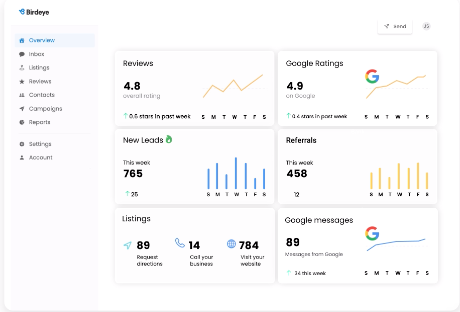
Birdeye Enterprise survey software is a marketing and reputation management software that aids in the public awareness of enterprises.
It enables users to keep track of, respond to, and monitor reviews, as well as turn user input into useful insights.
The built-in Natural Language Processing (NLP) engine can be used by users to compare and monitor performance, analyze trends, and comprehend consumer sentiment.
Additionally, a unified communications inbox, open APIs, and a customizable CRM are included.
Features of Birdeye.
1.Online reviews: Create and manage online reviews to enhance SEO functionality and draw in more clients. Create customized widgets for reviews, subscribe to instant alerts, and post them on corporate websites and social media.
Through a central dashboard, invite reviewers to provide their opinions and then publish their reviews on sites like Amazon, Facebook, Healthgrades, Zillow, and others.
2.Unified Inbox: Manage interactions with cutting-edge features in a single inbox. Assign individual chats to particular teammates, send attachments and photos, and receive automated review responses.
Access reviews, recommendations, polls, messages, emails, voicemails, and more in one location while viewing the experience scores of consumers and their interaction history to develop tailored responses.
3.Surveys: Construct surveys with a variety of question kinds, sophisticated display logic, and a user-friendly interface. Send surveys to customers, internal staff, interactive Pulse Surveys with two-way feedback, and more.
With Robin Automation, convert text exchanges into surveys. Follow up with respondents via email, video, or chat, inform the team of their responses, and transform survey feedback into useful insights.
4.Reports: Access multiple reports created utilizing information from a company profile and client testimonials in chart and table forms. track the performance of reviews and ratings over time. View and monitor, among other information, platform utilization, visitor statistics, average response times, and campaign performance. Download the reports in Excel and PDF formats.
5.Webchat: Include an editable chat widget on your website and set it up with a manual response system. To accept appointments, announce operating hours, and handle crises, send automated messages.
With the aid of Google Analytics, you can engage visitors in real-time chats, create leads through business texting, and learn how visitors utilize webchat.
6.Pages: Create bespoke pages that are mobile-friendly for each region to improve SEO. Create individualized pages with brand-specific information, business hours, and online reviews.
Allow consumers to search by city, zip code, and interactive maps by adding additional search choices. Utilize a centralized repository to manage data.
7.Integrations: This Enterprise survey software Integrate CRMs, accounting software, business management applications, eCommerce platforms, and more.
8.Ticket Management: Convert answers, texts, WebChat messages, comments on social media, and reviews into support requests to efficiently resolve concerns. based on particular criteria, such as ratings, reviews, and keywords, automatically create workflows.
Assign tickets to team members and prioritize them accordingly. Monitor the status, reaction time, and resolution speed.
Cons for Birdeye.
- Cost: BirdEye is somewhat costly. Simple plans begin at $199 per month or $1,990 annually.
- Limited integrations: Although BirdEye interfaces with numerous platforms, including MailChimp, Zapier, and Google Calendar, there are only a few different ways to combine them.
- There isn’t a free plan available, even though BirdEye provides a 15-day trial.
- Support for customers is provided by BirdEye, but only during regular business hours.
- The software is not robust and dynamic enough. It doesn’t offer a reliable atmosphere because it crashes frequently, making your work challenging and slow.
- Due to several problems that obstruct your work and annoy you, the user interface is insufficient.
8.Confirmit.
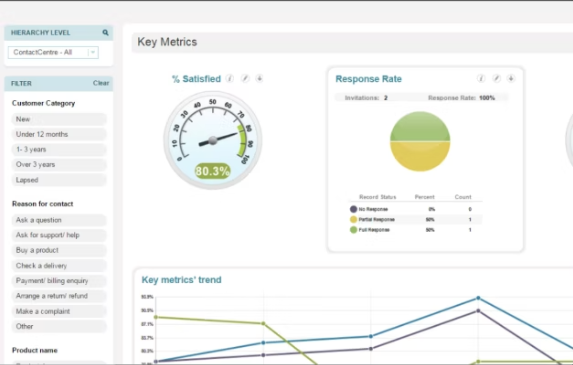
An enterprise’s customer and staff experiences are optimized by Confirmit Enterprise survey software, an end-to-end solution.
It offers market research services for product testing, segmentation, brand tracking, and loyalty analysis.
Feedback is quickly gathered thanks to multi-channel survey delivery via cell phones, emails, and QR codes.
Real-time, useful insights are uncovered with the use of its data analysis and reporting module. Management of panels, data gathering, sentiment analysis, and action planning are further abilities.
Features of Confirmit.
1.Dashboards and reporting: Use role-specific reports, dashboards, and other visualization tools to share critical information.
- Dashboards: A drag-and-drop dashboard can deliver data based on user demands. For important goals and benchmarks, use straightforward widget-based dashboards. Create dashboards for your business with advanced reporting.
- Mobile Reporting: Delivers reports directly to users’ mobile devices while they’re on the go.
- Automated warnings can ensure prompt action. To assign issues to the appropriate personnel, create roles with permissions and specified workflows.
- Real-time analytics: Quickly learn from input gathered through various methods. Separately store structured and unstructured data.
- Tracking: Keep track of survey results and analyze data in real-time. Analyze, sort, and view structured replies.
- Analyze textually: Data to determine customer intent, market trends, and product concerns. Implement sentiment analysis using AI and NLP.
2.Data Collection: Optimize the collection of data for initiatives that use customer, employee, and market perspectives.
- Web: Use web surveys to get customer feedback and make them available by email, mobile links, and overlays. Include a variety of questions kinds, along with multimedia materials.
- Telephone: Interactive voice response (IVR) and computer-assisted telephone interviewing are two telephone interviewing methods (CATI). Processes for call handling, live monitoring, and reporting should be combined.
- Offline: Conduct interviews offline using a variety of languages and multimedia prompts. On Windows, Android, and iOS devices, accessible to interviewers. Surveys can be self-completed by respondents using kiosk capabilities.
- Paper: With paper surveys, you can reach demographic groups that aren’t represented on digital platforms.
- SDK: Enables feedback gathering using mobile applications.
- Mobile: SMS, a mobile browser, or an app can be used to collect customer insights. Offers language capability, location data gathering, and visual aids.
3.Create interesting, creative surveys with the survey creator tool.
- Any language may include additional inquiry types.
- Deliver forms by phone, email, paper, mobile, or a combination of channels, and customize them with rich media content and brand-centric information.
- Utilize unstructured data like text, audio, and video to the fullest potential to cut down on survey time. Organize and map all the data in SmartHub.
- From a Microsoft Word document, produce surveys automatically.
4.Panel Management: Create incentive programs and customize panels to reflect the brand of the company. To manage huge groups spanning several segments, use the professional panel module.
5.Action Management: This Enterprise survey software immediately allocate pertinent staff people or departments to customer complaints. helps customer service identify at-risk customers and handle cases.
On their phones, employees can get personalized notifications. offers permissions and workflows based on actions.
9.Inmoment Enterprise survey software .
The cloud-based experience intelligence platform InMoment unifies consumer, employee, and business experiences.
Users can design customized reports and dashboards with real-time data sets and share them with others, improving customer relations.
For employee perspectives and market insights, respectively, organizations can use the EX and MX Cloud.
Smart surveys, in-the-moment responses, social media monitoring, and more are provided by Active Listening Studio.
Access versatile interfaces with CRMs, APIs, HRIs, social media, and other traditional communication channels to automate workflows, collect data from third-party modules, evaluate feedback, and handle situations.
Additionally, it provides case management, data management, data exploration, action planning, and other services.
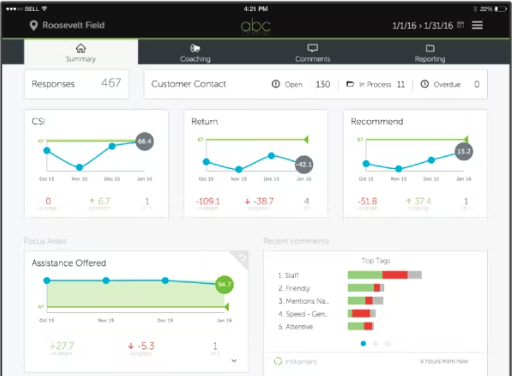
Features of Inmoment.
1.Use surveys: such as the NPS, CES, and CSAT/PSAT to obtain information. Make micro surveys and surveys that are scalable and multilingual. Send out surveys by text message, email, QR code, links, intercom messenger, and in-app communications.
2.Management of feedback: Utilize AI-powered engines to rapidly respond to customer feedback, monitor survey frequency, and point clients in the direction of useful recommendations. Gather multimodal information by utilizing social media and review websites.
3.Integrations: Link up with already-installed technology, such as that from Google, Facebook, Oracle, Adobe, Salesforce, Slack, Hubspot, and Zendesk, among others.
4.Data Analysis: Making data-driven judgments requires analysis of comments, reviews, videos, and online feedback. Conduct A/B tests to assess impact. Keep an eye on new initiatives and product launches.
5.Dashboards and Reporting: Create and export reports, dashboards, and live data sets using dashboards and reporting. Get automatic reports, which will show insights for the appropriate stakeholders.
6.Case management: Resolve issues and prevent bad outcomes with suggested actions and knowledgeable notifications. Manage, designate, prioritize, and keep an eye on both occasional incidents and recurring occurrences within the system.
7.Text analysis: This Enterprise survey software Spot trends, opportunities, and feelings in comments, reviews, and transcripts. To assign tags and themes that fit the organization’s language, use custom layered models.

